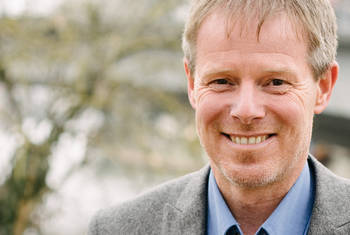Edward A. Vessel How Do Aesthetic Experiences Function in the Brain?
Edward A. Vessel is a Research Scientist at the Max Planck Institute for Empirical Aesthetics. Having completed his Ph.D. at the University of Southern California, Vessel has previously held a number of research positions at New York University. His main research interests include the neural basis of aesthetic experience, the neurobiology of information foraging and brain imaging. The recipient of a postdoctoral National Research Service Award, Vessel has also been funded by NASA to examine sensory stimulation augmentation tools for long-duration exploration spaceflight.
Area of Research
The Neural Basis of Aesthetic Experience, Visual Preferences, The Neurobiology of Information Foraging, Brain Imaging Methods
since 2016
2014-2015
Full Research Scientist
New York University
Center for Brain Imaging
since 2010
Co-Director, NYU ArtLab.
New York University
2009-2014
Assistant Research Scientist
New York University
Center for Brain Imaging
2011
Adjunct Professor
New York University
Dept. of Psychology
2008-2009
Research Consultant
New York University
Nava Rubin, Center for Neural Science
2007-2008
Adjunct Lecturer
New York University
Dept. of Psychology, Dept. of English
2004-2007
Postdoctoral Research Fellow
New York University
Center for Neural Science (Advisor: Nava Rubin)
2004
Ph.D., Neuroscience
The University of Southern California (USC)
Behavioral and Neural Investigations of Perceptual Affect
1997
B.A. (Hons.), Cognitive Science
Johns Hopkins University
- Reviewer for: Cognition; Cognition & Emotion; Cognitive Neuroscience; Cortex; Current Biology; Emotion; Frontiers in Human Neuroscience; Frontiers in Psychology; Human Brain Mapping; Journal of Experimental Psychology, Human Perception and Performance
- Journal of Personality and Social Psychology; Journal of Vision; Music Perception; Neuropsychologia; Psychology of Aesthetics, Creativity, and the Arts; Perception; PLoS ONE; Psychonomic Bulletin & Review; Scientific Reports
- Social Cognitive and Affective Neuroscience; IEEE Transactions on Information Forensics & Security; Wires
- Editor for Peer J. Guest editor for special issue of Frontiers in Neuroscience, “How variable, stable, or universal are aesthetic preferences?”
- International Association of Empirical Aesthetics (since 2013)
- Cognitive Neuroscience Society (since 2003)
- Vision Sciences Society (since 2001)
- Association for Psychological Science (2013-2015)
- Organization for Human Brain Mapping (OHBM) (2010-2015)
- Society for Neuroscience (1998-‘03,’08,‘19)
Prizes
- Panelist, World Science Festival (2013)
- Postdoctoral NRSA award (NEI) (2003-2006)
- Sensory Stimulation Augmentation Tools for long Duration Exploration Spaceflight (NNJ13HF11P (PI)) (2013-2015))
- Gobal Institute for Advanced Studies (Co-Investigator, PI Gabrielle Starr), 5/14 – 8/16 (New York University, $600,000, Beauty and Beyond Research Institute)
- University Research Challenge Fund (Co-Investigator, PI Gabrielle Starr), 06/11 – 08/14 (New York University, $18,000, Mapping the aesthetic brain: the neural topography of domain-general visual aesthetics)
 © Maximilian Dörrbecker
© Maximilian Dörrbecker
Max Planck Society
Frankfurt am Main, Germany"The Max Planck Society is Germany's most successful research organization. Since its establishment in 1948, no fewer than 18 Nobel laureates have emerged from the ranks of its scientists, putting it on a par with the best and most prestigious research institutions worldwide. The more than 15,000 publications each year in internationally renowned scientific journals are proof of the outstanding research work conducted at Max Planck Institutes – and many of those articles are among the most-cited publications in the relevant field." (Source)
Institute
Max Planck Institute for Empirical Aesthetics
The objective of the Max Planck Institute for Empirical Aesthetics is to arrive at a deeper understanding of the mechanisms, elicitors and functions of aesthetic liking and aesthetic preferences: Who appreciates what and why and under which conditions? And what functions do aesthetic practices and preferences serve for individuals, social groups and societies? The research focuses primarily on the foundations of aesthetic evaluation, perception and experience. (Source)
Map
Aesthetic experiences make a vital contribution to our lives. In this video, focusing on responses to artwork, architecture and natural landscapes, EDWARD VESSEL explores how aesthetic experiences function in the brain. Employing functional Magnetic Resonance Imaging (fMRI), Vessel attempts to correlate subjects’ aesthetic responses with data from two brain regions, the ventral occipitotemporal cortex and the default mode network. Extending our understanding of the role and function of these brain networks, Vessel’s research may have important implications beyond cognitive neuroscience, for how we learn and for human health and well being.
LT Video Publication DOI: https://doi.org/10.21036/LTPUB10774
Stronger Shared Taste for Natural Aesthetic Domains than for Artifacts of Human Culture
- Edward A. Vessel, Natalia Maurer, Alexander H. Denker and G. Gabrielle Starr
- Cognition
- Published in 2018
Art Reaches Within: Aesthetic Experience, the Self and the Default Mode Network
- Edward A. Vessel, G. Gabrielle Starr and Nava Rubin
- Frontiers in Neuroscience
- Published in 2013
The Default-mode Network Represents Aesthetic Appeal that Generalizes Across Visual Domains
- Edward A. Vessel, Ayse Ilkay Isik, Amy M. Belfi, Jonathan L. Stahl and G. Gabrielle Starr
- Proceedings of the National Academy of Sciences
- Published in 2019









